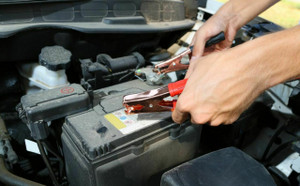How to jumpstart a car
By Kijiji Autos
If you drive a car with any regularity, chances are that eventually you will have to jumpstart a dead battery. You might have left your headlights on, or an interior light, or maybe somebody else did and they need a jump. In any case, it’s good car knowledge and safety to learn how to safely jumpstart a car. That way you can get back on the road with both your car and person intact.
Step 1: Determine if a Dead Battery Is Actually the Problem
Important note: You cannot jumpstart a hybrid. Hybrid vehicles use a different type of battery, and only a dealer or repair center with the proper equipment can restart a dead hybrid.
On a petrol vehicle, if the motor easily turns over without starting, turn on the headlights and see if they dim when you try to start the vehicle. If they don’t dim, it’s likely that the battery is not dead and something else is preventing the engine from starting.
On the other hand, if you try to start the car and hear only a soft clicking noise, or even no sound at all, it is possible that your battery is dead.
Step 2 – Park the Two Cars in Front of or Beside Each Other
Most vehicle’s batteries are located in the engine compartment under the hood, but even if the vehicle’s battery is located elsewhere there will be battery terminals in the engine compartment (refer to the owner’s manual if you are unsure). The battery terminals are the clamps that connect to the battery’s connection points (also known as poles) on the top of the battery.
The jumper cables need to reach the batteries in both vehicles, so park them accordingly. You will find it best to park the car with the working battery in front or beside the car with the dead battery, depending on where under the hood the battery terminals of each vehicle are located.
Step 3 – Inspect the Battery Terminals
A bad connection not only can drain a battery’s charge, it also can prevent a car from starting. If there appears to be corrosion on the dead vehicle’s battery, remove the terminals and clean them and the connection points with a wire brush or a knife. Battery corrosion looks like a white or gray ash-like substance. You can also use baking soda mixed with a bit of water to clean the terminals and connection points. If the terminals are loose, tighten the bolts. In the event that the terminal bolts are stripped, you can secure (tighten) the connection by wedging a metal screw, washer or nail between the battery terminal and its connection point on the battery. This however, is only a temporary fix, and the battery terminal should be replaced as soon as possible.
Step 4 – Connect the Jumper Cables (Leads)
Red goes on the positive (“+”) battery terminal and black goes on the negative (“-”). If the battery connections aren’t color coated, then look for a ‘+’ and ‘-’ stamped into the battery casing. Connect the leads to the dead battery first. Connect the positive cable first, then the negative cable second. Keep the opposite ends of the jumper cables from touching by clamping one of the clamps to the cable itself, clearly away from the other clamp. If they touch, sparks will fly, and the vehicle’s electrical system could get shorted out.
When connecting to the good battery, again connect the red (positive) lead to the positive terminal on the battery first, then connect the black lead to an unpainted metal surface under the hood (NOT the negative battery terminal of the good battery). The negative battery terminal is connected directly to the alternator, and when the dead vehicle starts a small amount of current will be sent back through the negative wire. If there’s a short in the dead vehicle’s electrical system, a large amount of current could be sent back through the jumper cable that can short out the entire electrical system on the vehicle that has the good battery.
Step 5 – Attempt to Start the Dead Vehicle
With the vehicle with the good battery shut off, attempt to start the dead vehicle (this will protect the electrical system on the good vehicle). If the dead car fails to start, turn on the good vehicle, then hold its gas pedal at ¼ throttle for 3-5 minutes. This will send a charging current from the running vehicle’s alternator directly to the dead vehicle’s battery. Once you’ve done that, try starting the dead car again.
Once the dead vehicle starts, remove the jumper cables in the opposite order you attached them. Again, be sure to prevent the clamps from touching. Let both vehicles run to recharge both their batteries.
If the dead vehicle fails to start after following these steps, have the vehicle towed and diagnosed by a mechanic.
Easily find your next ride on Kijiji Autos
Search nowCosts of Installing an Electric Car (EV) Charging Station in Canada
Installing a home EV charger can come with additional fees beyond purchase and installation. Here's a list of factors that can affect the price of a home EV charger.Toronto to Calgary Road Trip: Routes & Tips
Planning on driving from Toronto to Calgary? Here are some routes and tips to help you along the way.7 items you can fit in an SUV: TVs, mattresses and more
Discover seven common items that fit in an SUV below.Flat Tire vs Blowout: What's the Difference & What Should You Do?
The main difference between a flat tire and a blowout is that a blowout often feels like an explosion has occurred underneath your vehicle. Blowouts can cause sudden and drastic changes to the handling of your vehicle and can lead to minor or even serious accidents.Tips to help protect your vehicle and budget for car repairs
When shopping for your next vehicle, it's always a good idea to keep hidden costs in mind. Before you buy, let's look at how much it can cost to maintain a car in Canada, how much you could budget for annual maintenance and repairs, and how to help protect your car against damage and depreciationWhat is the value of undercoat protection on your vehicle?
When you buy a new vehicle, protecting it so that it lasts as long as possible is definitely top of mind, whether that's through security upgrades or an extra coat of paint. But how often do you consider the care and safety of your vehicle’s undercarriage?The top three best paint protection options for your vehicle
Buying a new vehicle is a great experience. Nothing beats hitting the road in a car you bought fresh off the lot. However, as fun as it is to finally get behind the wheel of your new ride, it's important to take your time through the process.Financial guide: post-pandemic car shopping and gas price hacks
With populations locked down and international borders closed the global supply chain has been disrupted on a massive scale, pushing up inflation around the world and raising the cost of everything that people need to get back to normal. Here are a few tips you can use to grab the vehicle you want without breaking the bank.10 tips to help make the road a better and happier place
We have all, at some point, been responsible for making the roadways stressful in one way or another. Alternatively, we are all equally capable of making the road a happier place. Let’s explore 10 unique ways we can help make the driving experience better again, for everyone's sake.10 eco-driving tips that can help you save money and reduce your carbon footprint
With rising gas prices, carbon taxes on fuel and concerns about climate change, many Canadians are wondering how to save gas when driving. Experts recommend adopting eco-driving techniques that can help you save money and fuel. Read on to discover 10 of them:








